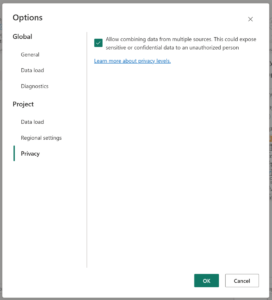If you’ve built a Power BI dataflow that combines between sources, most likely you’ve been stopped by a prompt asking if you want to “continue” because there is a risk that data could be revealed from one source to another.
The prompt’s wording makes it sound like you must choose “continue” in order to be able to use dataflows to output data derived from more than one data source—but is continuing truly mandatory?
The seeming necessity of enabling this option is reinforced by how the corresponding setting appears in the dataflow’s Options dialog. Clicking “continue” in the above prompt sets this checkbox. Its wording implies that it must be checked in order for Power Query to be able to combine between multiple data sources: If you don’t check it, you won’t be allowed to combine data from more than one source—or so it (incorrectly) seems.
Thankfully, in most cases, you do no need to enable this option in order to combine between sources.
Continue reading →

![Screenshot of prompt:
The evaluation was canceled because combining data from multiple sources may reveal data from one source to another. Click Continue if the possibility of revealing data is okay.
[Continue button]](https://bengribaudo.com/wp-content/uploads/2023/07/EvaluationCanceled-ContinueToCombine-1024x179.png)
